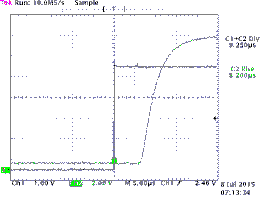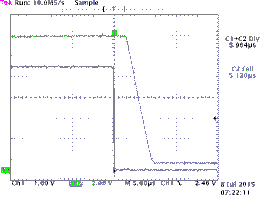SLLS961C July 2009 – June 2022 SN65HVDA195-Q1
PRODUCTION DATA
- 1 Features
- 2 Applications
- 3 Description
- 4 Revision History
- 5 Description (continued)
- 6 Pin Configuration and Functions
- 7 Specifications
- 8 Parameter Measurement Information
-
9 Detailed Description
- 9.1 Overview
- 9.2 Functional Block Diagram
- 9.3 Feature Description
- 9.4 Device Functional Modes
- 10Application and Implementation
- 11Device and Documentation Support
- 12Mechanical, Packaging, and Orderable Information
Package Options
Mechanical Data (Package|Pins)
- D|8
Thermal pad, mechanical data (Package|Pins)
Orderable Information
10.1.1.3 Application Curves
Figure 10-2 and Figure 10-3 show the propagation delay from the TXD pin to the LIN pin for both the recessive to dominant and dominant to recessive states under lightly loaded conditions.
 Figure 10-2 SN65HVDA195-Q1 Dominant to Recessive Prop Delay
Figure 10-2 SN65HVDA195-Q1 Dominant to Recessive Prop Delay Figure 10-3 SN65HVDA195-Q1 Recessive to Dominant Prop Delay
Figure 10-3 SN65HVDA195-Q1 Recessive to Dominant Prop Delay